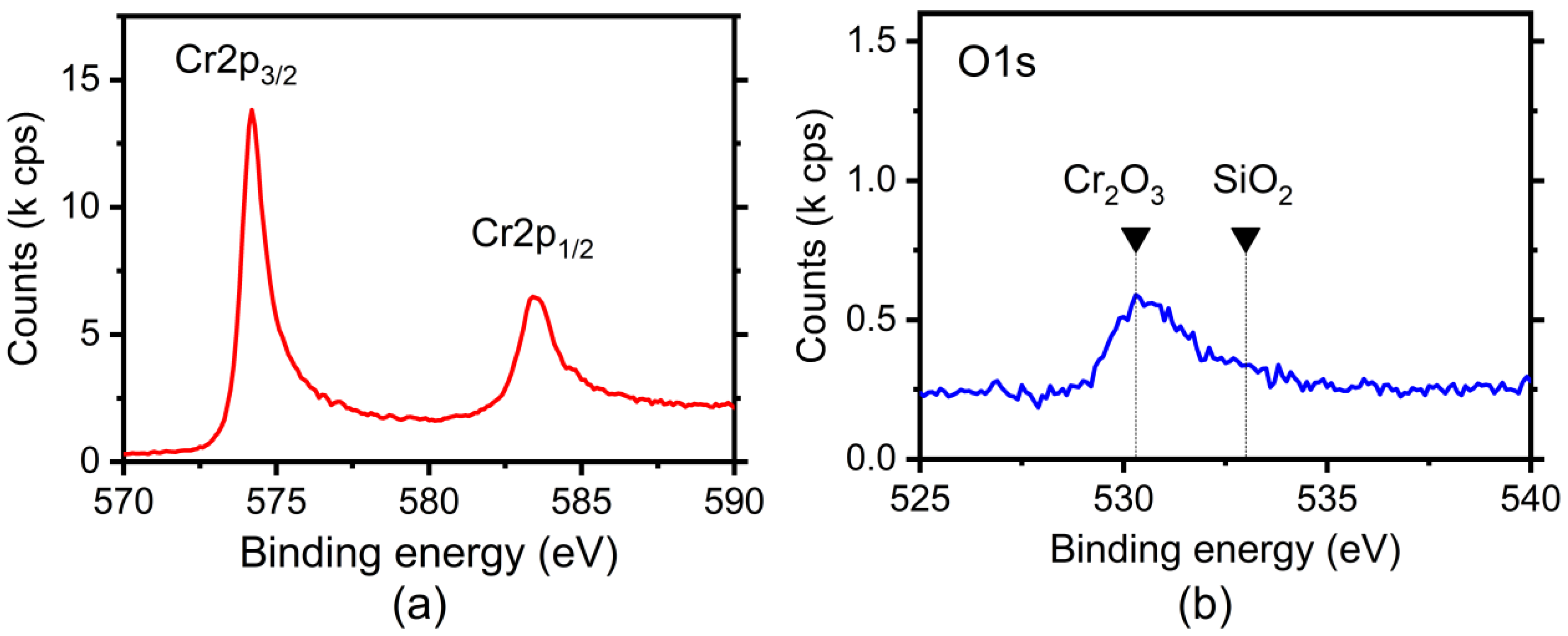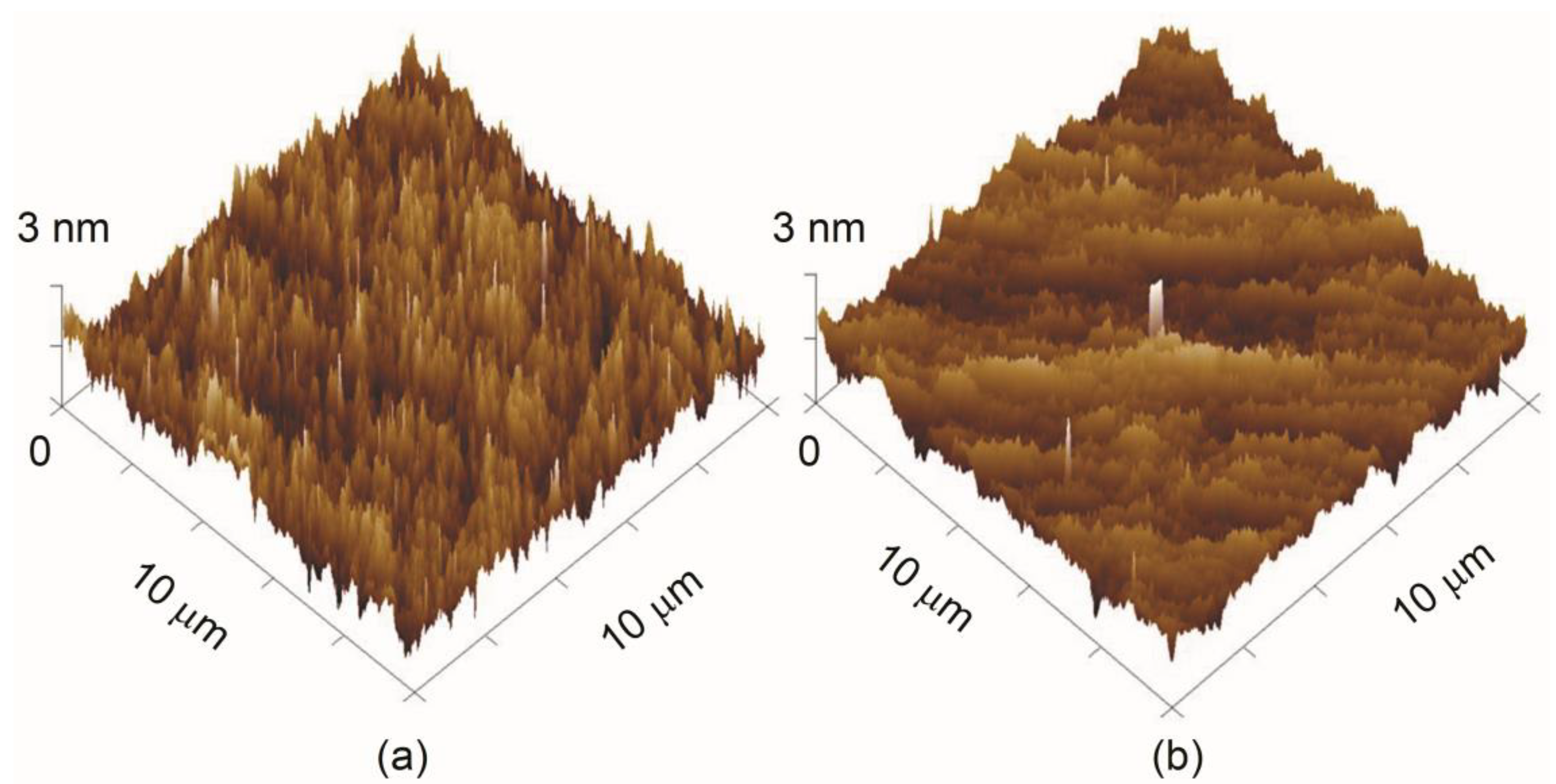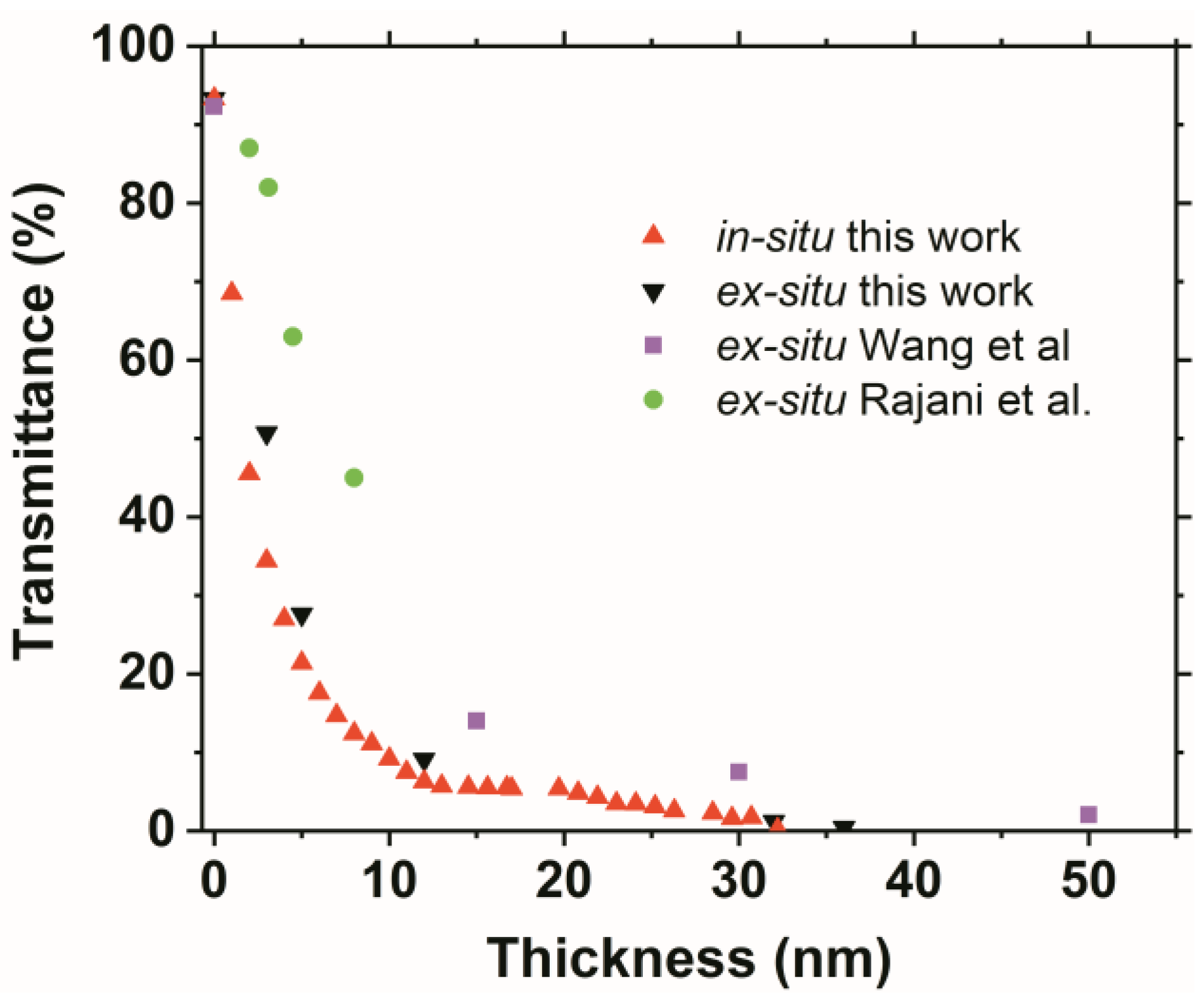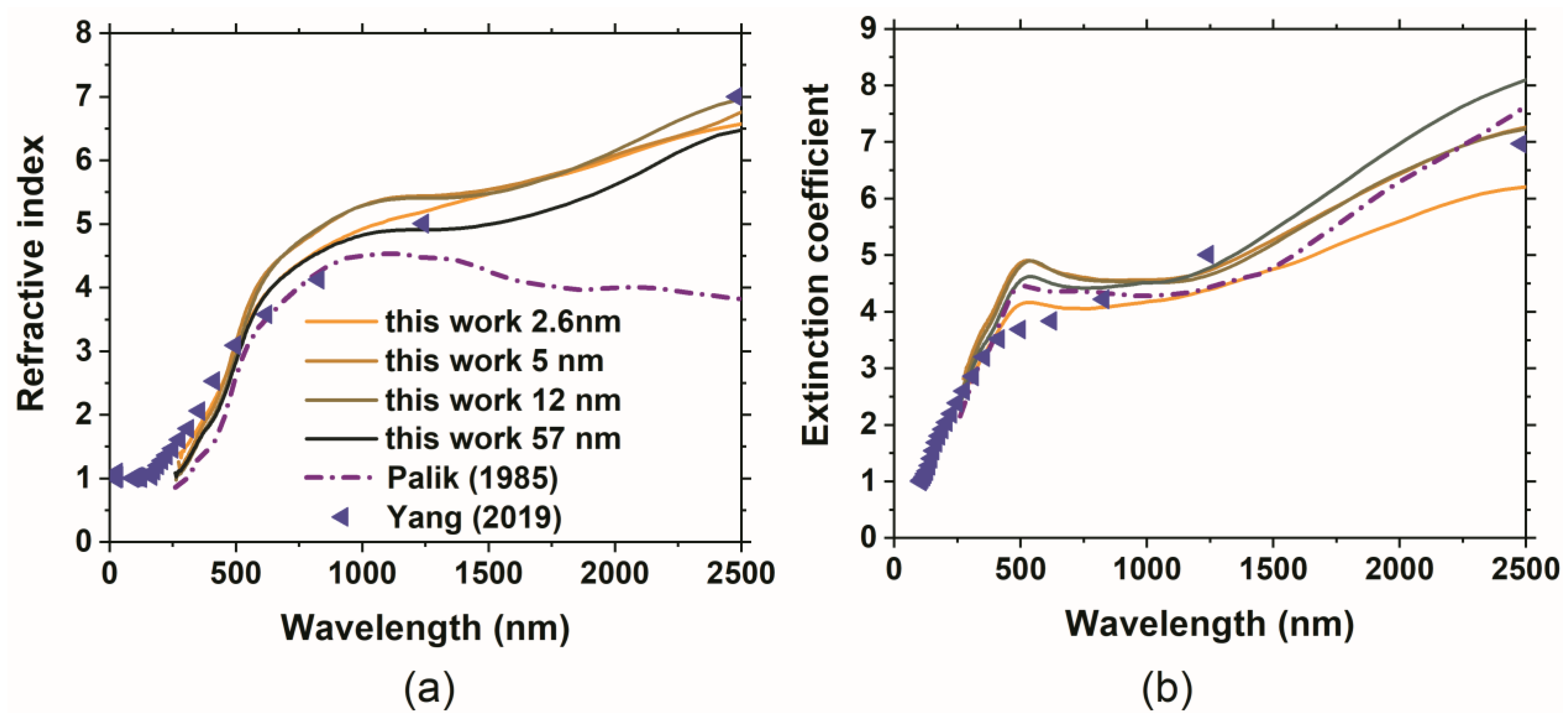Growth of Magnetron-Sputtered Ultrathin Chromium Films: In Situ Monitoring and Ex Situ Film Properties
Abstract
:1. Introduction
2. Experimental Details
3. Results and Discussion
3.1. Plasma Emission Monitoring and Elemental Composition
3.2. Surface Characteristics
3.3. Optical Properties
3.4. Electrical Properties
4. Conclusions
Author Contributions
Funding
Institutional Review Board Statement
Informed Consent Statement
Data Availability Statement
Conflicts of Interest
References
- Ding, Y.; Zhang, F.; Yan, S.; Li, H.; He, J.; Yin, F. Microstructure, Micro-Indentation, and Scratch Behavior of Cr Films Prepared on Al alloys by Using Magnetron Sputtering. Metals 2019, 9, 1330. [Google Scholar] [CrossRef]
- Lozanova, V.; Lalova, A.; Soserov, L.; Todorov, R. Optical and electrical properties of very thin chromium films for optoelectronic devices. J. Phys. Conf. Ser. 2014, 514, 012003. [Google Scholar] [CrossRef]
- Rajani, K.V.; Daniels, S.; McNally, P.J.; Lucas, F.O.; Alam, M.M. Ultrathin chromium transparent metal contacts by pulsed dc magnetron sputtering. Phys. Status Solidi 2010, 207, 1586–1589. [Google Scholar] [CrossRef]
- Zervas, M.N. Surface plasmon–polariton waves guided by thin metal films. Opt. Lett. 1991, 16, 720–722. [Google Scholar] [CrossRef]
- Vial, A.; Laroche, T. Description of dispersion properties of metals by means of the critical points model and application to the study of resonant structures using the FDTD method. J. Phys. D Appl. Phys. 2007, 40, 7152–7158. [Google Scholar] [CrossRef]
- Hüger, E.; Dörrer, L.; Yimnirun, R.; Jutimoosik, J.; Stahn, J.; Paul, A. Lithium permeation within lithium niobate multilayers with ultrathin chromium, silicon and carbon spacer layers. Phys. Chem. Chem. Phys. 2018, 20, 23233–23243. [Google Scholar] [CrossRef]
- Norkus, M.; Skaudžius, R. Enhanced NIR Region Emission of Chromium by Changing the Chromium Concentration in Yttrium Aluminum Garnet (YAG) Host Matrix. J. Alloys Compd. 2022, 908, 164601. [Google Scholar] [CrossRef]
- Dhas, C.R.; Venkatesh, R.; Sivakumar, R.; Dhandayuthapani, T.; Subramanian, B.; Sanjeeviraja, C.; Raj, A.M.E. Electrochromic performance of chromium-doped Co3O4 nanocrystalline thin films prepared by nebulizer spray technique. J. Alloys Compd. 2019, 784, 49–59. [Google Scholar] [CrossRef]
- Shy, S.-L.; Lei, T.F.; Chu, C.H.; Chang, C.-Y.; Lee, S.H.; Loong, W.-A. Very Simple Data Processing System for Deep Submicron Nanofabrication. In Proceedings of the Electron-Beam, X-ray, and Ion-Beam Submicrometer Lithographies for Manufacturing IV, SPIE’s, 1994, Symposium on Microlitography, 27 February–4 March 1994, San Jose, CA, USA; Patterson, D., Ed.; SPIE: Bellingham, WA, USA, 1994; pp. 287–295. [Google Scholar] [CrossRef]
- Bloch, E.; Mistele, D.; Brener, R.; Cytermann, C.; Gavrilov, A.; Ritter, D. NiCr thin film resistor integration with InP technology. Semicond. Sci. Technol. 2011, 26, 105004. [Google Scholar] [CrossRef]
- Miller, R.; Holland, H. Crystallographic orientation of sputtered Cr films on glass and glass–ceramic substrates. Thin Solid Films 1997, 298, 182–186. [Google Scholar] [CrossRef]
- Chiang, K.-T.K.; Wei, R. Growth morphology and corrosion resistance of magnetron sputtered Cr films. Surf. Coatings Technol. 2011, 206, 1660–1665. [Google Scholar] [CrossRef]
- Kashkarov, E.; Sidelev, D.; Rombaeva, M.; Syrtanov, M.; Bleykher, G. Chromium coatings deposited by cooled and hot target magnetron sputtering for accident tolerant nuclear fuel claddings. Surf. Coatings Technol. 2020, 389, 125618. [Google Scholar] [CrossRef]
- Chen, N.; Chen, L.; Li, Y.; Li, W.; Zhao, Y.; Wang, Z.; Wang, X.; Bu, Y. Design and fabrication of metameric interference thin films based on metal-dielectric structure for optical security devices. Surf. Coatings Technol. 2019, 364, 392–397. [Google Scholar] [CrossRef]
- Lunk, H.-J. Discovery, properties and applications of chromium and its compounds. ChemTexts 2015, 1, 6. [Google Scholar] [CrossRef]
- Wang, Z.-Y.; Hu, E.-T.; Cai, Q.-Y.; Wang, J.; Tu, H.-T.; Yu, K.-H.; Chen, L.-Y.; Wei, W. Accurate Design of Solar Selective Absorber Based on Measured Optical Constants of Nano-thin Cr Film. Coatings 2020, 10, 938. [Google Scholar] [CrossRef]
- Rahimi, H.; Karimi, M.; Ghajarpour-Nobandegani, S. Chromium nanostructures for enhancing light trapping in a thin-film solar cell. Opt. Mater. 2021, 121, 111548. [Google Scholar] [CrossRef]
- Wang, S.-F.; Lin, H.-C.; Bor, H.-Y.; Tsai, Y.-L.; Wei, C.-N. Characterization of chromium thin films by sputter deposition. J. Alloys Compd. 2011, 509, 10110–10114. [Google Scholar] [CrossRef]
- Ferreira, A.A.; Silva, F.J.G.; Pinto, A.G.; Sousa, V.F.C. Characterization of Thin Chromium Coatings Produced by PVD Sputtering for Optical Applications. Coatings 2021, 11, 215. [Google Scholar] [CrossRef]
- Kim, T.J.; Thio, T.; Ebbesen, T.W.; Grupp, D.E.; Lezec, H.J. Control of optical transmission through metals perforated with subwavelength hole arrays. Opt. Lett. 1999, 24, 256–258. [Google Scholar] [CrossRef]
- Mroczyński, R.; Iwanicki, D.; Fetliński, B.; Ożga, M.; Świniarski, M.; Gertych, A.; Zdrojek, M.; Godlewski, M. Optimization of Ultra-Thin Pulsed-DC Magnetron Sputtered Aluminum Films for the Technology of Hyperbolic Metamaterials. Crystals 2020, 10, 384. [Google Scholar] [CrossRef]
- Grilli, M.L.; Vernhes, R.; Hu, G.; Di Sarcina, I.; Dikonimos, T.; Sytchkova, A.; Martinu, L.; He, H.; Piegari, A. Characteristics of Ultrathin Ni Films. Phys. Status Solidi 2019, 216, 1800728. [Google Scholar] [CrossRef]
- Cortazar-Martínez, O.; Torres-Ochoa, J.-A.; Raboño-Borbolla, J.-G.; Herrera-Gomez, A. Oxidation mechanism of metallic chromium at room temperature. Appl. Surf. Sci. 2021, 542, 148636. [Google Scholar] [CrossRef]
- Safi, I. Recent aspects concerning DC reactive magnetron sputtering of thin films: A review. Surf. Coatings Technol. 2000, 127, 203–218. [Google Scholar] [CrossRef]
- Musil, J.; Baroch, P.; Vlček, J.; Nam, K.; Han, J. Reactive magnetron sputtering of thin films: Present status and trends. Thin Solid Films 2005, 475, 208–218. [Google Scholar] [CrossRef]
- Anders, A. Tutorial: Reactive high power impulse magnetron sputtering (R-HiPIMS). J. Appl. Phys. 2017, 121, 171101. [Google Scholar] [CrossRef]
- Greene, J.E. Tracing the recorded history of thin-film sputter deposition: From the 1800s to 2017. J. Vac. Sci. Technol. A Vac. Surf. Film. 2017, 35, 05C204. [Google Scholar] [CrossRef]
- Sytchkova, A.; Belosludtsev, A.; Volosevičienė, L.; Juškėnas, R.; Simniškis, R. Structural, optical and electrical properties of sputtered ultrathin chromium films. Opt. Mater. 2021, 121, 111530. [Google Scholar] [CrossRef]
- Wu, W.-Y.; Hsiao, B.-H.; Chen, P.-H.; Chen, W.-C.; Ho, C.-T.; Chang, C.-L. CrNx films prepared using feedback-controlled high power impulse magnetron sputter deposition. J. Vac. Sci. Technol. A Vac. Surf. Film. 2014, 32, 02B115. [Google Scholar] [CrossRef]
- Bryan, H.A.; Dean, J.A. Extraction and Flame Spectrophotometric Determination of Chromium. Anal. Chem. 1957, 29, 1289–1292. [Google Scholar] [CrossRef]
- Šlapanská, M.; Hecimovic, A.; Gudmundsson, J.T.; Hnilica, J.; Breilmann, W.; Vašina, P.; von Keudell, A. Study of the transition from self-organised to homogeneous plasma distribution in chromium HiPIMS discharge. J. Phys. D Appl. Phys. 2020, 53, 155201. [Google Scholar] [CrossRef]
- de Monteynard, A.; Schuster, F.; Billard, A.; Sanchette, F. Properties of chromium thin films deposited in a hollow cathode magnetron powered by pulsed DC or HiPIMS. Surf. Coat. Technol. 2017, 330, 241–248. [Google Scholar] [CrossRef]
- Song, L.; Mazumder, J. Real Time Cr Measurement Using Optical Emission Spectroscopy During Direct Metal Deposition Process. IEEE Sens. J. 2011, 12, 958–964. [Google Scholar] [CrossRef]
- Benien, H.; Maushart, J.; Meyer, M.; Suchentrunk, R.D.c. magnetron sputtering of oxidation-resistant chromium and CrN films monitored by optical emission spectrometry. Mater. Sci. Eng. A 1991, 139, 126–131. [Google Scholar] [CrossRef]
- Siepa, S.; Danko, S.; Tsankov, T.V.; Mussenbrock, T.; Czarnetzki, U. On the OES line-ratio technique in argon and argon-containing plasmas. J. Phys. D Appl. Phys. 2014, 47, 445201. [Google Scholar] [CrossRef]
- Tam, P.; Cao, Y.; Nyborg, L. Thin film characterisation of chromium disilicide. Surf. Sci. 2013, 609, 152–156. [Google Scholar] [CrossRef]
- Musil, J.; Zenkin, S.; Kos, S.; Čerstvý, R.; Haviar, S. Flexible hydrophobic ZrN nitride films. Vacuum 2016, 131, 34–38. [Google Scholar] [CrossRef]
- Belosludtsev, A.; Houška, J.; Vlček, J.; Haviar, S.; Čerstvý, R.; Rezek, J.; Kettner, M. Structure and properties of Hf-O-N films prepared by high-rate reactive HiPIMS with smoothly controlled composition. Ceram. Int. 2017, 43, 5661–5667. [Google Scholar] [CrossRef]
- Houska, J.; Kozak, T. Distribution of O atoms on partially oxidized metal targets, and the consequences for reactive sputtering of individual metal oxides. Surf. Coatings Technol. 2020, 392, 125685. [Google Scholar] [CrossRef]
- Kaiser, N. Review of the fundamentals of thin-film growth. Appl. Opt. 2002, 41, 3053–3060. [Google Scholar] [CrossRef]
- Lovrinčić, R.; Pucci, A. Infrared optical properties of chromium nanoscale films with a phase transition. Phys. Rev. B 2009, 80, 205404. [Google Scholar] [CrossRef]
- Belosludtsev, A.; Kyžas, N. Real-time in-situ investigation of copper ultrathin films growth. Mater. Lett. 2018, 232, 216–219. [Google Scholar] [CrossRef]
- Belosludtsev, A.; Sytchkova, A.; Kyžas, N.; Bitinaitis, I.; Simniškis, R.; Drazdys, R. Comparison of in-situ investigation of silver ultrathin films growth with the ex-situ resistance and ellipsometric measure-ments. Vacuum 2021, 195, 110669. [Google Scholar] [CrossRef]
- Kar, C.; Jena, S.; Udupa, D.V.; Rao, K.D. Tamm plasmon polariton in planar structures: A brief overview and applications. Opt. Laser Technol. 2023, 159, 108928. [Google Scholar] [CrossRef]
- Vyunishev, A.M.; Bikbaev, R.G.; Svyakhovskiy, S.E.; Timofeev, I.V.; Pankin, P.S.; Evlashin, S.A.; Vetrov, S.Y.; Myslivets, S.A.; Arkhipkin, V.G. Broadband Tamm plasmon polariton. J. Opt. Soc. Am. B 2019, 36, 2299–2305. [Google Scholar] [CrossRef]
- Lin, J.; Lin, L.; Guan, G.; Wu, Y.; Lai, F. Structural, Optical and Electrical Properties of Chromium Thin Films Prepared by Magnetron Sputtering. Guangzi Xuebao/Acta Photonica Sin. 2012, 41, 922–926. [Google Scholar] [CrossRef]
- Udachan, S.L.; Ayachit, N.H.; Udachan, L.A. Impact of substrates on the electrical properties of thin chromium films. Ing. Y Univ. 2019, 23, 1–19. [Google Scholar] [CrossRef]








Disclaimer/Publisher’s Note: The statements, opinions and data contained in all publications are solely those of the individual author(s) and contributor(s) and not of MDPI and/or the editor(s). MDPI and/or the editor(s) disclaim responsibility for any injury to people or property resulting from any ideas, methods, instructions or products referred to in the content. |
© 2023 by the authors. Licensee MDPI, Basel, Switzerland. This article is an open access article distributed under the terms and conditions of the Creative Commons Attribution (CC BY) license (https://creativecommons.org/licenses/by/4.0/).
Share and Cite
Belosludtsev, A.; Sytchkova, A.; Baltrusaitis, K.; Vaicikauskas, V.; Jasulaitiene, V.; Gric, T. Growth of Magnetron-Sputtered Ultrathin Chromium Films: In Situ Monitoring and Ex Situ Film Properties. Coatings 2023, 13, 347. https://doi.org/10.3390/coatings13020347
Belosludtsev A, Sytchkova A, Baltrusaitis K, Vaicikauskas V, Jasulaitiene V, Gric T. Growth of Magnetron-Sputtered Ultrathin Chromium Films: In Situ Monitoring and Ex Situ Film Properties. Coatings. 2023; 13(2):347. https://doi.org/10.3390/coatings13020347
Chicago/Turabian StyleBelosludtsev, Alexandr, Anna Sytchkova, Kazimieras Baltrusaitis, Viktoras Vaicikauskas, Vitalija Jasulaitiene, and Tatjana Gric. 2023. "Growth of Magnetron-Sputtered Ultrathin Chromium Films: In Situ Monitoring and Ex Situ Film Properties" Coatings 13, no. 2: 347. https://doi.org/10.3390/coatings13020347






